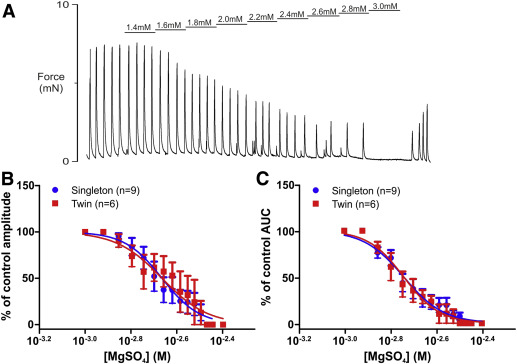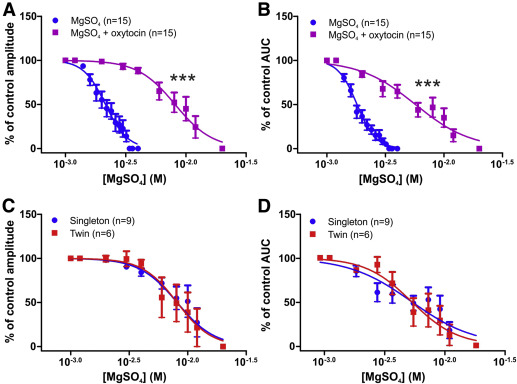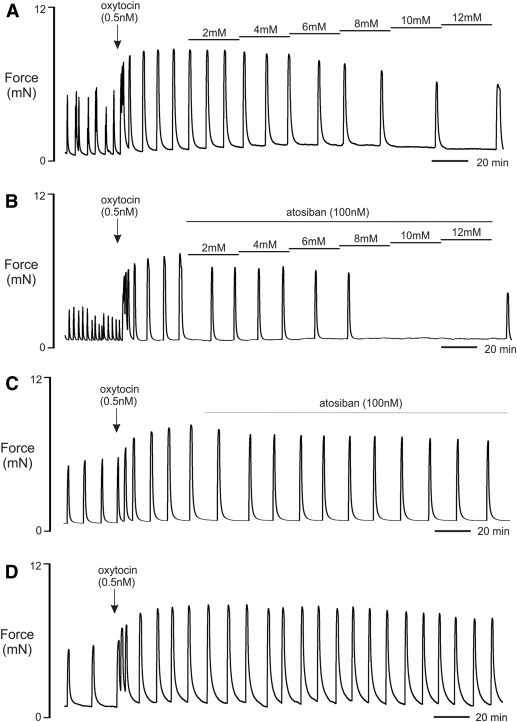Background
Preterm birth at <37 weeks of gestation is the most common and costly complication of pregnancy and remains the leading cause of neonatal morbidity, death, and reduced achievement in surviving infants. Magnesium sulfate is 1 class of tocolytics for threatened preterm labor; however, its clinical efficacy has been questioned. Twin pregnancies are at increased risk of preterm delivery compared with singleton gestations, which suggests that there is twin-specific risk to preterm delivery in twins. The prevention strategies that are applied to singleton pregnancies, however, have not been shown to be effective in twin pregnancies.
Objective
The purpose of this study was to compare the relaxant effect of magnesium sulfate on spontaneous and oxytocin-augmented contractions of human myometrium from singleton and twin pregnancies and to examine whether the effect of oxytocin on magnesium sulfate’s potency could be reversed with the use of the oxytocin receptor antagonist, atosiban.
Study Design
Myometrium was obtained at the time of prelabor cesarean section (36-40 weeks of gestation) from women with singleton (n=23) or twin (n=12) pregnancy. Isometric tension recordings were made on myometrial strips that were mounted in organ baths that were superfused with physiologic saline solution. Strips were exposed to rising concentrations of magnesium sulfate, and the effect on spontaneous contractions or stimulated with oxytocin (0.5 nmol/L) and in the presence or absence of atosiban (100 nmol/L) was recorded. The contractile characteristics after each application of magnesium sulfate, which included amplitude of contraction and activity integral, were measured. Concentration-response curves were fitted with the use of nonlinear regression and comparison of the negative logarithm of the 50% reduction in activity values.
Results
Magnesium sulfate exerted an equal concentration-dependent inhibitory effect on spontaneous myometrial contractions from both singleton and twin myometrium ( P> .05). The application of oxytocin produced a significant rightward shift in the concentration-response curves ( P< .0001), but no differences were found between pregnancy groups ( P> .05). The addition of atosiban shifted concentration-response curves significantly back to the left for amplitude of contraction and activity integral in singletons ( P <.0001). However, only activity integral was significantly reversed in twins ( P <.01).
Conclusion
Magnesium sulfate is equipotent in suppressing contractions in singleton and twin myometrium. Oxytocin (0.5 nmol/L) significantly reduces the tocolytic potency of magnesium sulfate, which may explain, in part, magnesium sulfate’s poor efficacy in vivo; however, this can be reversed partially by the use of an oxytocin receptor antagonist. Combination tocolysis that involves oxytocin receptor antagonists requires further investigation.
Preterm birth (delivery <37 weeks of gestation) is the leading cause of perinatal morbidity and death. Most cases of preterm birth result from spontaneous preterm labor onset that involves premature uterine contractions or premature rupture of the membranes. A number of pharmacologic agents have been advocated as suppressants of uterine contractions (tocolytics) and include magnesium sulfate (MgSO 4 ).
In vitro, magnesium is known to relax smooth muscle; studies in myometrium have also found magnesium to decrease both spontaneous and induced (eg, with oxytocin) uterine contractions significantly. However, despite these clear laboratory findings, few clinical trials have found MgSO 4 tocolysis in vivo to be effective in the prevention of preterm birth or reduction of newborn morbidities or death when compared with an alternative or no tocolytic (placebo) treatment. This lack of efficacy has led the obstetric community to question its use as a tocolytic. The American College of Obstetricians and Gynecologists and the Society for Maternal-Fetal Medicine limit their support for the use of MgSO 4 for “short-term prolongation of pregnancy (up to 48 hours) to allow for the administration of antenatal corticosteroids in pregnant women who are at risk of preterm delivery within 7 days.”
In vitro studies have shown that the concentration of magnesium that is required to abolish spontaneous contractions is approximately 2–3 mmol/L but that the concentrations that are required to inhibit oxytocin-augmented contractions are much greater (approximately 8–10 mmol/L), which is much higher than that reported to be safe therapeutically. We therefore questioned: Could we use an oxytocin receptor antagonist to increase the tocolytic potential of MgSO 4 by removing the negative influence of oxytocin on magnesium’s potency?
Multiple pregnancies (eg, twins) are confounded especially by higher rates of preterm birth with approximately 50–60% of twins reported to deliver preterm compared with approximately 11% of singletons, which suggests that there is a twin-specific risk to preterm delivery. The preterm birth prevention strategies that are applied to singleton pregnancies have not been found to be effective in twin pregnancies, and the evidence for the use of tocolysis in twins is limited.
The aims of this study were to investigate (1) the inhibitory effect of MgSO 4 on spontaneous and oxytocin-augmented contractions on strips of human myometrium in our ex vivo model, (2) to examine for differences in the potency of MgSO 4 between myometrium from singleton and twin pregnancies, and (3) whether the effects of oxytocin could be reversed or reduced with the use of the oxytocin receptor antagonist, atosiban.
Materials and Methods
Sample collection and preparation
Myometrial tissue was obtained with written informed consent from 35 women who underwent elective, prelabor cesarean delivery. All women were between 23 and 43 years of age, with a singleton (n=23) or twin (n=12) pregnancy, between 36–40 weeks of gestation. Full details of the demographics for all women according to pregnancy group (singleton or twin) are given in Table 1 . As expected, the median length of gestation was significantly shorter, and birthweight (combined in the case of twins) was significantly higher in the twin group ( P< .001). Local Research Ethics committee (Liverpool East, REC Ref 10/H1002/49) and institutional review boards of the Research and Development Department, Liverpool Women’s Hospital and University of Liverpool, approved the study.
| Characteristic | Combined (n=35) | Singletons (n=23) | Twins (n=12) |
|---|---|---|---|
| Maternal age, y a | 32±5.2 | 32±4.3 | 31.5±5.6 |
| Maternal body mass index, kg/m 2 b | 25.0 (23–29.7) | 27.5 (23.4–33.7) | 23.8 (22.4–27.0) |
| Gestational age, d b | 273 (264–275) | 274 (272–275) | 263 (259–264) c |
| Birthweight, g b | 3870 (3465–4920) | 3690 (3270–3880) | 5207 (4388–5817) c |
| Parity, n (%) | |||
| 0 | 11 (31.4) | 6 (26.1) | 5 (41.7) |
| 1 | 13 (37.1) | 8 (34.9) | 5 (41.7) |
| >1 | 11 (31.4) | 9 (39.1) | 2 (16.7) |
| Reason for cesarean delivery, n (%) | |||
| Previous cesarean delivery | 18 (51.4) | 17 (73.9) | 1 (8.3) |
| Previous difficult vaginal delivery | 1 (2.9) | 1 (4.3) | 0 |
| Breech | 2 (5.7) | 0 | 2 (16.7) |
| Fetal reason | 3 (8.6) | 1 (4.3) | 2 (16.7) |
| Maternal reason | 4 (11.4) | 4 (17.4) | 0 |
| Maternal choice | 7 (20.0) | 0 | 7 (58.3) |
a Data are given as mean+standard deviation
b Data are given as median (interquartile range)
c Indicates significantly shorter gestation in twins and significantly greater birthweight in twins (Kruskal Wallis Test, P< .05).
At operation, myometrial tissue was excised from the upper lip of the lower uterine incision site after delivery of the baby and placenta. Samples were used immediately or within 12 hours of collection with storage at 4°C. In the laboratory, multiple strips (5×2×1 mm) were dissected along the direction of longitudinal fibers, as previously described. Strips were attached to aluminum clips and placed in 1-mL organ baths continually superfused with physiologic saline solution (PSS; in millimoles/liter: 154 NaCl, 5.6 KCl, 1.2 MgSO 4 , 7.8 glucose, 10.9 HEPES, and 2.0 CaCl 2 ) at a rate of 1.5 mL/min, pH 7.4 at 36°C. One end was attached to a fixed hook, and the other was attached to a FORT 10 g force transducer (World Precision Instruments, Hertfordshire, UK). Each sample was subjected to 2 mN stretch and left to equilibrate in PSS until spontaneous contractions were established, typically within 2 hours. Contractions were recorded at a sampling rate of 10Hz via a data acquisition system running the associated software (Labscribe 2; World Precision Instruments).
Experimental approach
The experimental methods were based on our previous studies of tocolytic potency in myometrium. For spontaneous contractions, strips were left to equilibrate for 1 hour after their onset or until a minimum of 4 consecutive contractions of equal amplitude and regular frequency were achieved. For oxytocin-induced contractions, strips were allowed to equilibrate then contractions were stimulated with oxytocin (0.5 nmol/L) for a minimum of 45 minutes to achieve a stable baseline activity, as previously described. Strips were then exposed to rising concentrations of either MgSO 4 alone or in combination with atosiban (100 nmol/L).
Each concentration of MgSO 4 was added at 20- to 25-minute intervals based on previous data that showed that maximal response to MgSO 4 is achieved at 20 minutes. Measurement of contractile activity was performed by calculation of the integral area under the tension curve in unit time referred to as “activity integral” or AUC (arbitrary units) and mean maximum peak amplitude of contraction (expressed as millinewton), as previously described. We have shown previously that spontaneous contractions remain stable for >3 hours of recording without significant decrease in amplitude or area under the curve during the time equivalent of experimental maneuvers. Control activity was taken as the contractile activity in the final 20–25 minutes (preceding the first concentration of MgSO 4 ). The effects of MgSO 4 during the final 20 minutes of its 25-minute exposure at each concentration (allowing for 5 minutes of turn-over in the tissue bath) were calculated and expressed as a percentage of the integral and amplitude during the control period (ie, control activity is equal to 100%).
Statistical analysis
Concentration-response curves were fitted to the logistic equation with the use of non-linear regression (PRISM 5.0; Graph Pad Software Inc, San Diego, CA). The mean half-maximal inhibitory concentration of MgSO 4 , which is the concentration of MgSO 4 that is required to cause a 50% reduction in activity (IC 50 ), was calculated to examine its inhibitory effects on contraction amplitude and activity integral. To compare the effect of MgSO 4 among the different experimental conditions or patient groups, the negative logarithm of the IC 50 (–logIC 50 ) values were taken and compared on the basis of the F test for the extra sum of squares principle. Unless stated otherwise, all values represent the mean±standard error of the mean, where ‘‘n’’ is the number of samples, and each represents a different woman. A probability value of <.05 was taken as level of significance.
Results
The application of MgSO 4 resulted in a dose-dependent decrease in both spontaneous contraction amplitude and activity integral in all samples tested (n=14: singleton n=8; twin= 6; Figure 1 ). For most samples (10/14), spontaneous contractions were abolished at a concentration of ≤3.2 mM MgSO 4 . On returning to normal PSS (1.2 mM MgSO 4 ), contractions recovered. The IC 50 for MgSO 4 on spontaneous contraction amplitude was 2.18±0.024 mM), and the activity integral was 1.80±0.014 mM. Concentration-response curves for MgSO 4 on spontaneous contractions according to pregnancy group (singletons or twins) are shown in Figure 1 , B and C, and the associated IC 50 values are given in Table 2 . As shown, the potency of MgSO 4 on spontaneous contraction amplitude and activity integral was equal in strips from both singleton and twin myometrium ( P> .05).

| Variable | Singleton (n=8), mM | Twin (n=6), mM | P value |
|---|---|---|---|
| Spontaneous | |||
| Amplitude | 2.15±0.027 | 2.23±0.043 | .4676 |
| Activity integral, area under the curve | 1.84±0.019 | 1.79±0.021 | .5214 |
| Oxytocin-augmented | |||
| Amplitude | 8.55±0.208 | 7.67±0.305 | .3034 |
| Activity integral, area under the curve | 5.81±0.230 | 5.77±0.236 | .9462 |
The concentration of MgSO 4 that was required to abolish contractions was significantly increased in the presence of oxytocin, compared with spontaneous conditions ( P <.0001; amplitude and activity integral). In a number of cases, contractions persisted even at 12 mM MgSO 4 , which is 10× the concentration in our PSS (ie, control concentration). Concentration-response curves for MgSO 4 in the presence and absence of oxytocin are shown in Figure 2 , A and B. The IC 50 for MgSO 4 under oxytocin was 8.13±0.066 mM for amplitude of contraction and 5.77±0.033 mM for activity integral (n=14, combined data; n=8 singletons, n=6 twins). When the data were stratified according to pregnancy group, there was no difference in the potency of MgSO 4 between singleton and twin myometrium on oxytocin-augmented contractions ( Figure 2 , C and D; Table 2 ).

In an effort to reverse the effect of oxytocin on MgSO 4 ’s potency, the effect of increasing concentrations of MgSO 4 on oxytocin-augmented contraction (as performed earlier) was examined in paired strips in the presence and absence of atosiban (100 nmol/L, based on our previous study). Representative traces are shown in Figure 3 , A and B, and appropriate time controls for atosiban alone and oxytocin alone are shown in Figure 3 , C and D. As shown previously, contractions persisted for a number of hours in the presence of oxytocin without significant decrease in in amplitude or AUC. Similarly, the application of atosiban (100 nmol/L) alone resulted in an initial decrease in force which remained stable for the remainder of the experiment (n=12).





